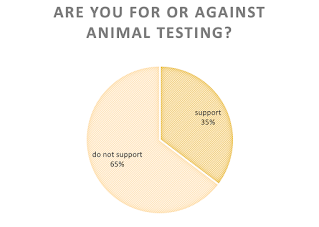Thank you for visiting! In this blog, I would like to show the reality of animal testing and discuss its future.
Saturday, July 24, 2021
NGO I created and reflections on my presentation
Thursday, July 15, 2021
Results of my Survey Monkey
I would like to share the results of my survey on animal testing. I don’t think there are so many people who are very familiar with animal testing, but in order to find out what those people think about animal testing, I conducted this survey. I used Instagram and LINE to find people to answer this survey, and 34 people answered my survey. Most of them are Japanese students.
First, I asked them about their impressions of animal testing. I had the impression that animal testing was cruel, so I expected that most people would be concerned about the animals in this survey as well. Of course, many of them said that they felt sorry for the animals and that it was inhumane, but on the other hand, others said that it was a necessary for our lives, so it was inevitable.
So, when I asked them whether they were for or against animal testing after that, 35% of them said they were for animal testing. I thought most people would be against it, so I was surprised that more than 10 people were for it. Those people who were in favor of animal testing thought that it was necessary for the development of new drugs and vaccines. Those who were against animal testing also thought that the experiments were conducted to advance science and reduce the risks to humans. I think this suggested that although most people share a common understanding of the purpose of animal testing, their opinions differ depending on whether they think it is inevitable or whether they think animal rights should be guaranteed.
Wednesday, July 14, 2021
The Reality of Animal Testing 2
I'd like to show the general idea of animal testing again. This post is also answers to my research questions.
First of all, how long has animal testing been done? It is said that the first person to use live animals for experiments was Erasistratus in ancient Greece (290 BC). There are many theories, but it is thought that experiments on animals began in the 17th century. The beginning of this idea was Descartes' advocacy that "animals are machines." He demonstrated that animals don't have spirits or emotions, so they're just machines. Therefore, he justified the use of animals by humans as tools for experimentation. Of course, I don't believe anyone thinks that way anymore, but the fact is that animal testing is still being done.
So what is the current thinking on this? The concept of the 3Rs, meaning Replacement, Reduction, and Refinement, is now widespread internationally. Many of the researchers conducting the experiments also believe that if there is an alternative method that does not use animals, they should use it, but that is still difficult to do right now. So they aim to reduce the burden on the animals by improving the experiment methods so that more useful information can be obtained. For this reason, in Japan, there is a requirement that the person conducting the experiment must be proficient in experimental techniques and the handling of laboratory animals. There are no specific qualifications required to do experiments, but there is an exam called the Laboratory Animal Technician Exam conducted by the Japanese Society for Laboratory Animal Resources, and it is recommended that people pass that exam to become qualified. In addition, it is required to take appropriate care of animals by managing, sterilizing, disinfecting, and preventing infection so as not to cause unnecessary pain and suffering, and to create a comfortable environment that reduces anxiety and stress for the animals when keeping them.
The next step is to know who will be conducting the experiment on the animal and for what purpose. Animal testing is used in more areas than we expect. For example, those who study basic biology and diseases, assessing the effectiveness of new medicinal products, and testing the human health or environmental safety, it is essential to use animals in their experiments. Many organizations are still relying on animals because there is currently no perfect alternative method that can mimic the entire human body. At the same time, however, there are those who argue that the use of animals in research is unreliable. Actually, more than 90 percent of drugs that have passed animal trials for safety and efficacy are not successful in treating the human disease for which they are intended.
松田幸久. (n.d.). gikan1.html. 動物とヒトとのかかわり ー特に医学において動物実験が果たした役割ー. Retrieved July 14, 2021, from http://www.med.akita-u.ac.jp/%7Edoubutu/gijutubu/gikan1.html
Tuesday, July 13, 2021
Word Cloud

